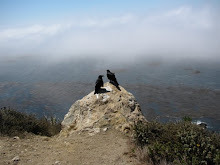As I've mentioned before, I love old buildings. They're among my favorite things to see when I'm traveling. When I traveled in Europe during my junior year abroad, I spent a ton of time exploring castles, ruins, and the like. Living in California, it's often difficult to experience places that are really old. Sure, Mission Dolores in San Francisco was founded in 1776, followed by the city of San Jose in 1777. But neither the church nor the city feel old.
Then I go somewhere like Tughlaqabad, founded in 1321. It's a ruined fort and city that lies in the southern part of Delhi. Modern-day Delhi contains the remnants of a number of "cities" that have risen and fallen there, going as far back as the 11th century. Tughlaqabad is one of those ancient cities.
The overgrown grounds contain the crumbling remains of towers, storehouses, gateways, and residential quarters for both royalty and servants, all contained within a defensive wall that encircles the city. Nearly seven hundred years later, the city functions as a grazing area for cows and donkeys, and its buildings house stray dogs and a troop of rhesus macaques. In fact, it's said that a curse was put on Tughlaqabad when Nizzamudin, a Sufi mystic, became angered by the construction of the fort. The city was doomed to be inhabited only by shepherds – a curse which holds to this day.
Danny hired a guide for the first part of our excursion into the ancient ruins. This fellow pointed out where the queen's bath had been and told us why some of the gateways were so large (so that elephants could pass through). He walked us down into the market, where the narrow corridor was lined with low doorways that led into dark rooms, and showed us the thorn-covered entrance to a kilometer-long tunnel, which supposedly led to another fort across the way.
When the guided tour was over, we spent another couple of hours exploring, particularly looking for monkeys and birds and making sure we saw as much of the city as possible.
Like other historical sites we've been to, there is some writing on the walls, although not as much as we had seen before. Perhaps it's because Tughlaqabad is so far out of the way and doesn't seem to get a lot of visitors.
We then left the fort and crossed the street to the tomb of Ghiyadthu'd-din, the Tughlaq emperor who founded the city and the dynasty. It was quiet and mostly empty, except for a few people who were working on renovating the mausoleum, as well as a few pigeons and parrots.
As our excursion drew to a close, the sun was beginning to set, lighting up the sky in a particularly awesome way.
I will always love ruins and ancient buildings. The next time someone asks me what's my favorite part of traveling, I'll most likely say, "I love finding places that are truly old." Lately, I've been thinking about taking an archaeology class, since I'd love to be able to learn about the spaces where people once lived. In the meantime, though, I'll continue to visit and photograph them... and wonder about the history behind what I'm seeing.
Subscribe to:
Post Comments (Atom)









No comments:
Post a Comment